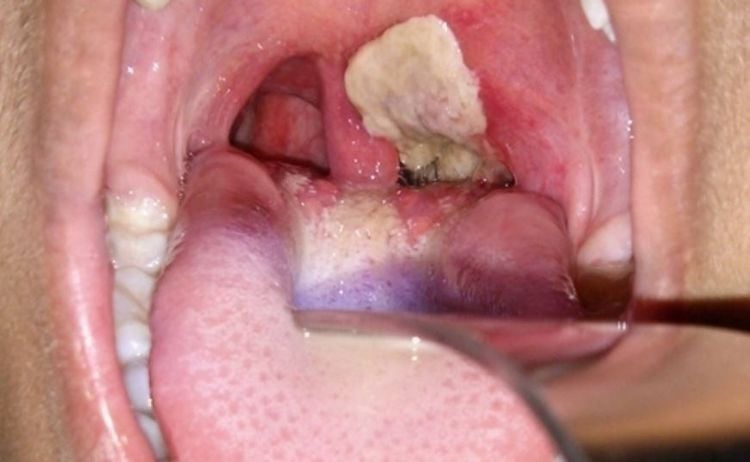This is an automatically translated article.
Diphtheria is an acute infection caused by the bacterium Corynebacterium diphtheriae. The disease can lead to serious complications such as pneumonia, myocarditis, arrhythmia, and even death.1. A brief overview of diphtheria
Diphtheria is an acute bacterial infection with pseudomembranous glands in the amygdala, larynx, pharynx, and nose. The disease can appear on the skin, conjunctiva of the eyes or genitals.
Cells containing diphtheria bacteria are sick people and healthy people carry the bacteria. The disease is transmitted by inhalation or contact with someone infected with the diphtheria bacteria. Besides, raw milk can also be a means of transmission of diphtheria bacteria. After being infected with the diphtheria bacteria, the patient usually has an incubation period of 2 to 5 days or more.
People with diphtheria have symptoms of sore throat, nose and larynx, red throat, pain when swallowing, pale skin, fatigue, swollen lymph nodes under the jaw causing swelling in the neck area. Within 2-3 days, gray, sticky plaques will appear in the pharynx, which if tried to remove can cause bleeding. Laryngeal diphtheria is a severe form of disease in children, with local manifestations as laryngeal pseudomembranous and systemic manifestations of neurotoxicity, paralysis of the cranial nerves, sensory nerves, and peripheral motor nerves. and myocarditis. The disease may pass or may cause death within 6 to 10 days. The mortality rate from the disease is 5-10%.
Complete and scheduled diphtheria vaccination is the most effective way to prevent diphtheria.
2. Characteristics of diphtheria bacteria
2.1 What is diphtheria bacteria? Diphtheria bacteria called Corynebacterium diphtheriae belongs to the family Corynebacteriaceae. This family includes the genera Corynebacterium, Erysipelothrix, Listeria, parasitic in soil, animals and humans. Most bacteria in the family Corynebacteriaceae do not cause disease, a few cause disease in humans. There are three types of diphtheria bacteria: Gravis, Mitis and Intermedius.
Diphtheria bacteria are gram-negative, aerobic bacteria. A well-ventilated diphtheria culture medium will help bacteria grow. In particular, this type of bacteria grows quickly in the presence of blood and serum.
2.2 Diphtheria bacteria morphology Diphtheria bacteria have diverse morphology. The typical morphology of diphtheria bacteria is a bacillus, with 1 or 2 enlarged ends, so it is also called a club-shaped bacillus, 2 - 6 μm long and 0.5 - 1 μm wide. Diphtheria bacteria are non-enveloped, non-spore forming, and non-motile.

Hình thái của vi khuẩn bạch hầu
2.3 Viability of diphtheria bacteria Diphtheria bacteria have high resistance outside the body, can withstand dry and cold weather. If covered by mucus, the diphtheria bacteria can live on objects for a few days to a few weeks, live for 30 days on cloth, 20 days in milk and water, and survive for 2 weeks. in cadaver.
However, diphtheria bacteria are quite sensitive to physical and chemical factors. Specifically, in direct sunlight, the diphtheria bacteria will die within a few hours. If living in diffused sunlight, this bacteria will be killed after a few days. At a temperature of 58 degrees Celsius, diphtheria bacteria survive for about 10 minutes and they only live for 1 minute under the influence of 1% phenol and 60 degrees of alcohol.
Diphtheria exotoxin is a heat-labile, antigen-specific, highly toxic protein that is not heat or formol tolerant. The exotoxins of diphtheria strains are similar. This is a powerful toxin. 1mg of diphtheria toxin can kill 1,000 guinea pigs weighing 250g after 6 hours. When exotoxins are treated with heat and formol, they lose their virulence, which is called antitoxin and is used as a vaccine against diphtheria.
2.4 Pathogenic mechanism of diphtheria bacteria When entering the respiratory tract, diphtheria bacteria will reside in the mucous membranes of the pharynx and pharynx and secrete exotoxins. Bacteria and toxins cause local ulcers, forming gray-white pseudomembranous, tightly adhered to the mucosa, which when dissected can cause bleeding. Pseudomembranous skin appears first in the pharynx, then spreads to the nasal passages or down the trachea, causing difficulty breathing. In addition, exotoxins also enter the bloodstream and affect the nervous system, causing symptoms such as paralysis of the palate, eye muscles, quadriplegia, damage to the adrenal glands, and effects on the heart, causing confusion. palpitations, heart failure, etc. In addition, pseudomembranous skin or wounds may appear, but the toxin dispersion is usually mild and does not cause many symptoms.

Vi khuẩn bạch hầu cư trú ở niêm mạc hầu, họng
Diphtheria can lead to many unpredictable complications in the heart, lungs and even death. Therefore, it is necessary to apply preventive measures such as ensuring personal hygiene and environmental hygiene, isolating people carrying diphtheria bacteria and administering the diphtheria toxoid vaccine according to the correct regimen.
The most effective way to prevent diphtheria is to get vaccinated fully and on time. Currently, Vinmec is providing a variety of diphtheria vaccination services for children and adults with 5 combinations, including:
● 6-in-1 vaccine Infanrix Hexa of GSK (Belgium)
● Vaccine- Apply for 6 in 1 Hexaxim of Sanofi (France)
Pentaxim 5 in 1 vaccine of Sanofi (France)
● Adacel 0.5 ml of Sanofi - France
● Tetraxim 0.5 ml of Sanofi - France
To ensure Immunization effectiveness and safety, before injection, customers will be examined by specialists, fully screened for physical and health problems, and advised on preventive vaccines and injection regimens. , monitoring and post-vaccination care before the appointment of vaccination according to the latest recommendations of the Ministry of Health & World Health Organization.
To register for examination and vaccination against diphtheria, you can contact the nationwide Vinmec Health System Hotline, or register online HERE.













